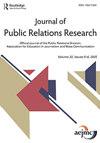Introduction to special issue: women and leadership in public relations
IF 4.4
2区 文学
Q1 COMMUNICATION
引用次数: 6
Abstract
Leadership and women in public relations is not on the mainstream research agenda. For example, a systematic literature review conducted in 2019 analyzed 223 papers on women in public relations from a period between 1982 and 2019, discovering a large focus on women’s experiences in their careers, such as the glass ceiling, pay gap and other gender-related barriers. Only very few studies specifically tackled leadership, and in that, these papers mainly focused on how women lead (Topić et al., 2020), which has been a focus of scholarly inquiry on women and leadership since pioneering studies into this issue (Aldoory, 1998; Aldoory & Toth, 2004). This is not to say that leadership in public relations is a largely unexplored area in general terms. For example, the Plank Center in the United States conducts globally renowned research into leadership in public relations and also collects information on public relations and leadership scholarship. But, when Plank’s list of articles and book chapters on leadership is reviewed (The Plank Center, n.d.), then a gap in women’s experiences again shows. This is changing, however, with more scholars expressing interest in this area. For example, a recent book by U.S. scholars Juan Meng and Marlene Neill (who are also authors of two articles in this issue) tackles women and leadership with a focus on ethics and breaking into leadership positions (Meng & Neill, 2021). In Europe, the EUPRERA project on “Women in Public Relations” looked specifically into leadership (along with lived experiences and office culture), and findings showed inequalities and barriers women face. For example, in a study on women and leadership in public relations in England, Topić (2020) found that women struggle to progress to leadership positions and when they do, they face a Catch-22: When women are too soft they are not seen as managerial material but when they are tough then they are labeled as “bitches,” the term also being mentioned among interviewees who do not hold managerial positions. The findings in the same study also showed that women who spent time with boys embraced (stereotypically) masculine characteristics such as toughness, assertiveness and directness, and these women progressed to leadership positions more easily. Socialization influences managerial preferences, so women who grew up socializing with girls usually prefer working for women managers, whereas women who grew up socializing with boys prefer working for men, with both groups of women disapproving of masculine women. In a Croatian study, Polić and Holy (2020) found that women who grew up with fathers and masculine mothers embraced masculine leadership styles, whereas women who grew up socializing with mothers or with both parents embraced feminine leadership styles; both groups preferred working for men with early experiences being linked to spending time with parents rather than peer groups as it was shown in an English case study (Topić, 2020). However, in Greece, women demonstrated the so-called “gyno-androus” leadership characterized by both masculine (self-confidence, planning and decisiveness) and feminine (emotional intelligence and empathy) traits, and also tend to support egalitarian and supportive leadership to prove their competencies (Triantafillidou & Yannas, 2021). These findings and the diversity of conclusions, along with different cultural contexts in which the studies were conducted, show the complexity of leadership and distinctive issues women face, justifying further research into this issue.特刊简介:妇女与公共关系中的领导
公共关系中的领导力和妇女不在主流研究议程上。例如,2019年进行的一项系统的文献综述分析了1982年至2019年间223篇关于公共关系中女性的论文,发现人们对女性职业经历的关注很大,如玻璃天花板、薪酬差距和其他与性别相关的障碍。只有极少数研究专门涉及领导力,因此,这些论文主要关注女性如何领导(Topićet al.,2020),自对这一问题进行开创性研究以来,这一直是关于女性和领导力的学术研究的焦点(Aldoory,1998;Aldoory和Toth,2004年)。这并不是说公共关系中的领导力在很大程度上是一个未被探索的领域。例如,美国普朗克中心对公共关系中的领导力进行了全球知名的研究,还收集了有关公共关系和领导力奖学金的信息。但是,当普兰克关于领导力的文章和书籍章节列表被审查时(普兰克中心,n.d.),女性经历的差距再次显现。然而,随着越来越多的学者对这一领域表示兴趣,这种情况正在发生变化。例如,美国学者Juan Meng和Marlene Neill(他们也是本期两篇文章的作者)最近的一本书探讨了女性与领导力,重点关注道德和进入领导岗位(Meng&Neill,2021)。在欧洲,EUPRERA关于“公共关系中的女性”的项目专门研究了领导力(以及生活经历和办公室文化),研究结果显示了女性面临的不平等和障碍。例如,在一项关于英国女性与公共关系领导力的研究中,Topić(2020)发现,女性很难晋升为领导职位,当她们晋升时,他们面临着第二十二条军规:当女性过于软弱时,她们不被视为管理材料,但当她们强硬时,她们就会被贴上“婊子”的标签,这个词也在没有担任管理职位的受访者中被提及。同一项研究的结果还表明,与男孩相处的女性具有(刻板印象中的)男性特征,如坚韧、自信和直率,这些女性更容易晋升为领导职位。社会化会影响管理偏好,因此与女孩社交长大的女性通常更喜欢为女性经理工作,而与男孩社交长大的男性更喜欢为男性工作,这两类女性都不赞成男性女性。在克罗地亚的一项研究中,Polić和Holy(2020)发现,与父亲和男性母亲一起长大的女性接受男性领导风格,而与母亲或父母双方一起社交长大的女性则接受女性领导风格;正如一项英国案例研究所示(Topić,2020),这两组人都更喜欢为早期有与父母相处经历的男性工作,而不是为同龄人工作。然而,在希腊,女性表现出所谓的“女性-男性”领导力,其特点是男性(自信、计划和果断)和女性(情商和同理心),也倾向于支持平等主义和支持性领导力,以证明自己的能力(Triantafillidou&Yannas,2021)。这些发现和结论的多样性,以及进行研究的不同文化背景,表明了领导力的复杂性和妇女面临的独特问题,有理由对这一问题进行进一步研究。
本文章由计算机程序翻译,如有差异,请以英文原文为准。
求助全文
约1分钟内获得全文
求助全文

 求助内容:
求助内容: 应助结果提醒方式:
应助结果提醒方式:


